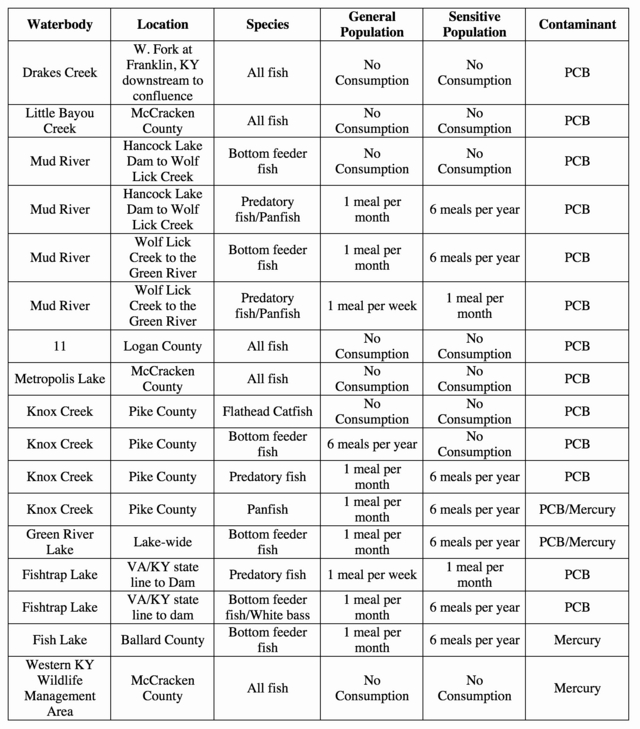| ||||||||||
Dr. Ronald P. Rogers CHIROPRACTOR Support for your body's natural healing capabilities 270-384-5554 Click here for details 


Columbia Gas Dept. GAS LEAK or GAS SMELL Contact Numbers 24 hrs/ 365 days 270-384-2006 or 9-1-1 Call before you dig Visit ColumbiaMagazine's Directory of Churches Addresses, times, phone numbers and more for churches in Adair County Find Great Stuff in ColumbiaMagazine's Classified Ads Antiques, Help Wanted, Autos, Real Estate, Legal Notices, More... 

|
Fish consumption advisory guidelines updated Several new changes to 2016 guidelines for fish caught in various Kentucky waters. Click on headline for charts with advisories, including warnings on certain fish from Green River Lake, lakewide, for PCB/mercury levels From Commonwealth News Center FRANKFORT, KY - (17 Feb 2016) - The statewide fish consumption advisory has been revised due to levels of mercury found in fish samples from Kentucky waters, the Kentucky Departments for Public Health, Environmental Protection, and Fish and Wildlife Resources announced today. Fish consumption advisories are intended to advise the public of potential adverse health problems that may result from eating fish caught from a particular area. An advisory does not ban eating fish; it is a guide to help citizens reduce risk and make informed decisions about eating fish from Kentucky waters. "We want Kentuckians to be informed about any potential danger or ill effects that could result from the food they consume - and that includes fish caught locally in our rivers, streams and lakes," said Kathy Fowler, director of the DPH Division of Public Health Safety. "Contaminants, like mercury, can be harmful to the brain and nervous system if a person is exposed to too much of them. We ask that Kentuckians be mindful of the kinds and amounts of fish they consume, particularly more sensitive populations such as infants, young children and pregnant women." Mercury occurs naturally and can also be released to the environment through many types of human activity. It can collect in streams and lakes where it is converted into methylmercury in the sediment. Once converted, methylmercury is absorbed by small organisms such as bacteria and plankton, which are then consumed by larger organisms progressing up the food chain to predatory fish such as largemouth bass, walleye and musky. According to 2009 United States Environmental Protection Agency document "The National Study of Chemical Residues in Lake Fish Tissue", mercury has been found in fish in all states including Kentucky. Kentucky's average mercury concentration in fish tissue is similar to national levels. Kentucky consumption advisories are developed based on the USEPA document "Guidance for Assessing Chemical Contaminant Data for Use in Fish Tissue Advisories" which outlines risk based consumption limits for methylmercury. Consumption advisories do not affect those who swim, ski or boat in Kentucky waters. Scroll down or Click to: Current KY standing individual fish consumption advisories And New fish from KY waters consumption advisory: 2016 This story was posted on 2016-02-17 15:08:11
Printable: this page is now automatically formatted for printing.
Have comments or corrections for this story? Use our contact form and let us know.
More articles from topic Healthy Lifestlyes by Kelli Bonifer:
Beshear starts campaign to fight Bevin's moves on health care Gov. Bevin names Stephen P. Miller Medicaid Commissioner KY Dept. for Public Health issues Zika virus prevention guide Voice of America health article says ZICA can be transmitted through sex Mary Keltner: Kentucky and Affordable Health Care Campbellsville HS students pledge to be organ donors Two articles, two sides on Kynect, Medicaid expansion Kentuckians are encouraged to get flu shots Walking Adair County (Columbia) KY: A personal metric Kentucky expanding colon cancer screening rates View even more articles in topic Healthy Lifestlyes by Kelli Bonifer |


|
||||||||
|
| ||||||||||
|
Quick Links to Popular Features
Looking for a story or picture? Try our Photo Archive or our Stories Archive for all the information that's appeared on ColumbiaMagazine.com. | ||||||||||
|
Contact us: Columbia Magazine and columbiamagazine.com are published by Linda Waggener and Pen Waggener, PO Box 906, Columbia, KY 42728. Please use our contact page, or send questions about technical issues with this site to webmaster@columbiamagazine.com. All logos and trademarks used on this site are property of their respective owners. All comments remain the property and responsibility of their posters, all articles and photos remain the property of their creators, and all the rest is copyright 1995-Present by Columbia Magazine. Privacy policy: use of this site requires no sharing of information. Voluntarily shared information may be published and made available to the public on this site and/or stored electronically. Anonymous submissions will be subject to additional verification. Cookies are not required to use our site. However, if you have cookies enabled in your web browser, some of our advertisers may use cookies for interest-based advertising across multiple domains. For more information about third-party advertising, visit the NAI web privacy site.
| ||||||||||






















































